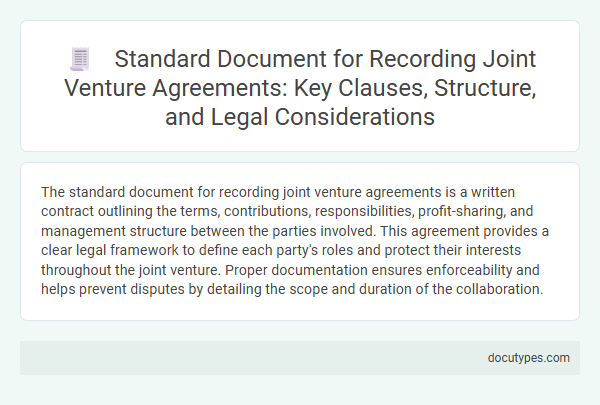The standard document for recording joint venture agreements is a written contract outlining the terms, contributions, responsibilities, profit-sharing, and management structure between the parties involved. This agreement provides a clear legal framework to define each party's roles and protect their interests throughout the joint venture. Proper documentation ensures enforceability and helps prevent disputes by detailing the scope and duration of the collaboration.
Introduction to Joint Venture Agreements
A Joint Venture Agreement is a legal document that outlines the terms and conditions between parties collaborating on a business project. This agreement defines the roles, responsibilities, and profit-sharing mechanisms among the partners involved.
- Definition: A Joint Venture Agreement formalizes the partnership between two or more entities working together on a specific project or business activity.
- Purpose: The agreement clarifies expectations, protects interests, and manages risks of all parties involved.
- Standard Document: Typically, a written contract serves as the standard document for recording joint venture agreements to ensure enforceability and legal compliance.
You should use this standard document to clearly establish terms and avoid future disputes in your joint venture.
Importance of Standardized Documentation
The standard document for recording joint venture agreements is the Joint Venture Agreement (JVA), a comprehensive contract outlining roles, responsibilities, and profit distribution. Properly drafted JVAs protect the interests of all parties and ensure clear operational guidelines.
- Clarity and Consistency - Standardized documentation provides uniform terms that minimize ambiguities and disputes between joint venture partners.
- Legal Protection - A well-structured JVA serves as a legally binding record that can be enforced in courts, safeguarding your business rights.
- Efficient Management - Standard documents streamline negotiation and execution processes, facilitating smoother collaboration and project management.
Essential Parties and Definitions
The standard document for recording joint venture agreements is the Joint Venture Agreement (JVA). This legal contract outlines the terms, responsibilities, and contributions of the involved parties.
Essential parties in a joint venture agreement typically include the joint venturers, who may be individuals, companies, or entities collaborating on a specific project. Clearly defining these parties establishes accountability and governance.
Key definitions within the agreement clarify important terms such as "contribution," "profit sharing," and "management structure." Precise definitions prevent misunderstandings and ensure all parties share a common understanding of the agreement's scope.
Including essential parties and accurate definitions in the Joint Venture Agreement facilitates smooth operations and dispute resolution. This clarity promotes effective collaboration and legal protection for all participants.
Key Clauses in a Joint Venture Agreement
The standard document for recording joint venture agreements is the Joint Venture Agreement itself, a legally binding contract that outlines the collaboration terms between parties. This document ensures clear understanding of each party's roles, responsibilities, and profit-sharing mechanisms.
Key clauses in a joint venture agreement establish the framework for successful cooperation and dispute resolution among partners.
- Purpose and Scope - Defines the objectives and the specific activities the joint venture will undertake.
- Capital Contributions - Details the amount and form of investment each party will provide to fund the venture.
- Profit and Loss Sharing - Specifies how revenues, costs, and risks will be distributed among parties involved.
- Management and Decision-Making - Outlines the governance structure and processes for operational control and dispute resolution.
- Duration and Termination - Sets the timeframe of the joint venture and conditions under which it may be dissolved.
Structure and Format of the Agreement
The standard document for recording joint venture agreements is commonly referred to as a Joint Venture Agreement (JVA). This legal contract outlines the terms, roles, responsibilities, and contributions of each party involved in the joint venture.
The structure of a Joint Venture Agreement typically includes sections such as the Purpose of the Joint Venture, Contributions and Ownership Interest, Management and Control, Profit and Loss Sharing, and Dispute Resolution. The format is designed for clarity, often presented in numbered clauses for easy reference. Essential details like duration, confidentiality, and termination conditions are clearly defined to ensure mutual understanding and enforceability.
Capital Contributions and Profit Sharing
| Standard Document for Recording Joint Venture Agreements | Joint Venture Agreement |
|---|---|
| Purpose | Defines roles, responsibilities, capital contributions, and profit sharing among partners |
| Capital Contributions | Specifies the amount and type of assets each party invests; may include cash, property, or services |
| Profit Sharing | Outlines the distribution of profits and losses according to agreed percentage or formula |
| Legal Importance | Serves as the primary binding document to prevent disputes over financial commitments and earnings |
| Customization | Can be tailored to fit Your specific business goals and contribution models within the venture |
Management and Decision-Making Provisions
What is the standard document for recording joint venture agreements? The standard document is the Joint Venture Agreement (JVA), which outlines the rights, responsibilities, and obligations of each party involved. Management and decision-making provisions within the JVA clearly define roles, authority limits, and processes for resolving disputes to ensure effective collaboration and governance.
Dispute Resolution and Termination Clauses
The standard document for recording joint venture agreements is a detailed contract outlining the roles, responsibilities, and contributions of each party involved. It includes specific clauses to manage potential conflicts and the terms under which the venture may be dissolved.
Dispute resolution clauses typically specify methods such as mediation, arbitration, or litigation to handle disagreements effectively. Termination clauses define conditions for ending the joint venture and procedures for asset distribution, ensuring clarity and legal compliance.
Legal and Regulatory Considerations
The standard document for recording joint venture agreements is the Joint Venture Agreement itself, which outlines the roles, responsibilities, and financial contributions of each party involved. Legal and regulatory considerations require this document to comply with local laws, ensuring enforceability and protection against disputes. You must ensure the agreement includes clauses on dispute resolution, governance, and compliance with relevant industry regulations to safeguard all parties' interests.
What Is the Standard Document for Recording Joint Venture Agreements? Infographic

